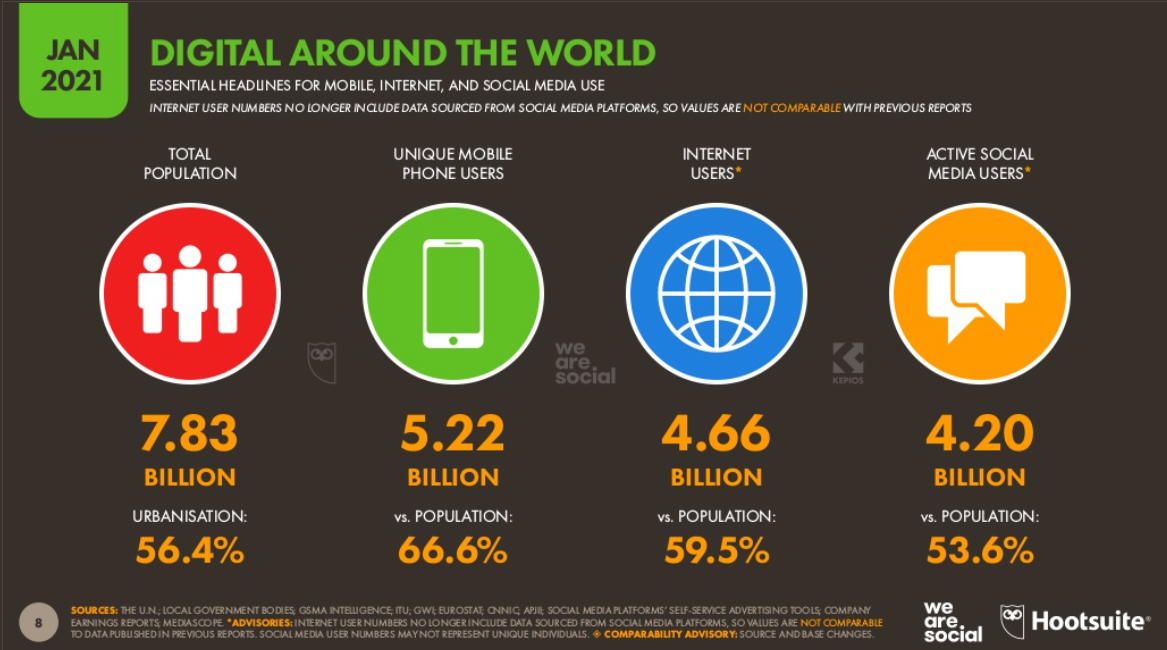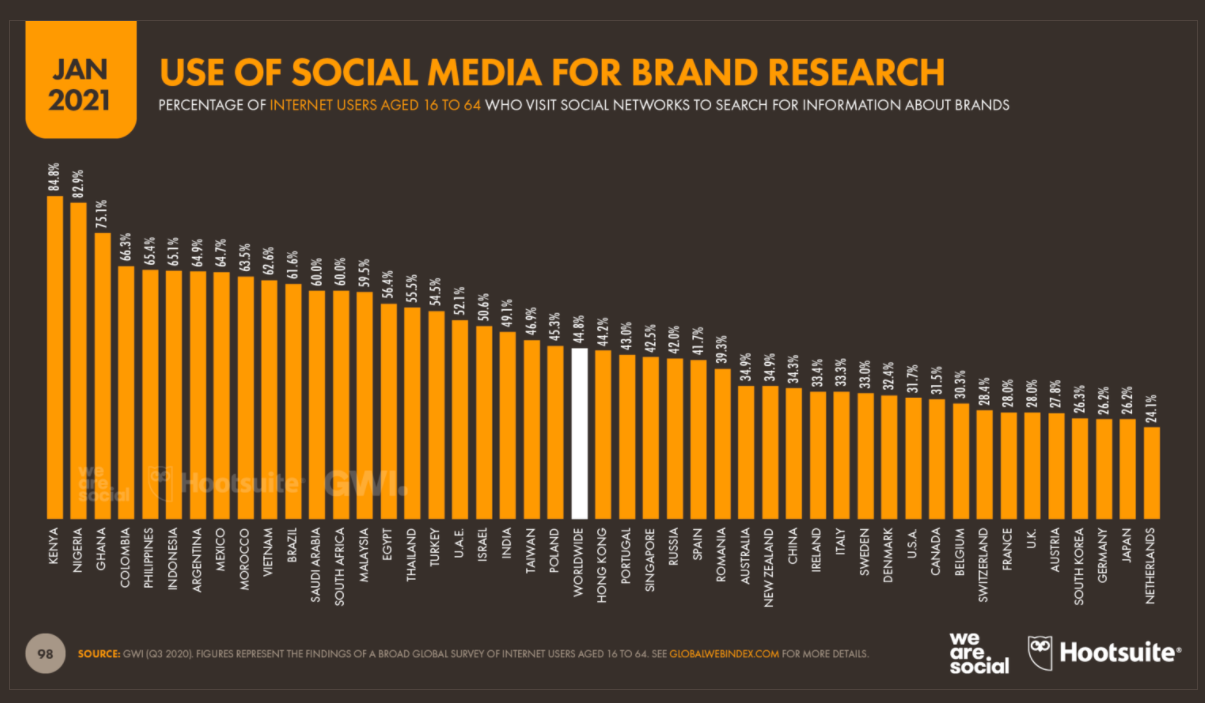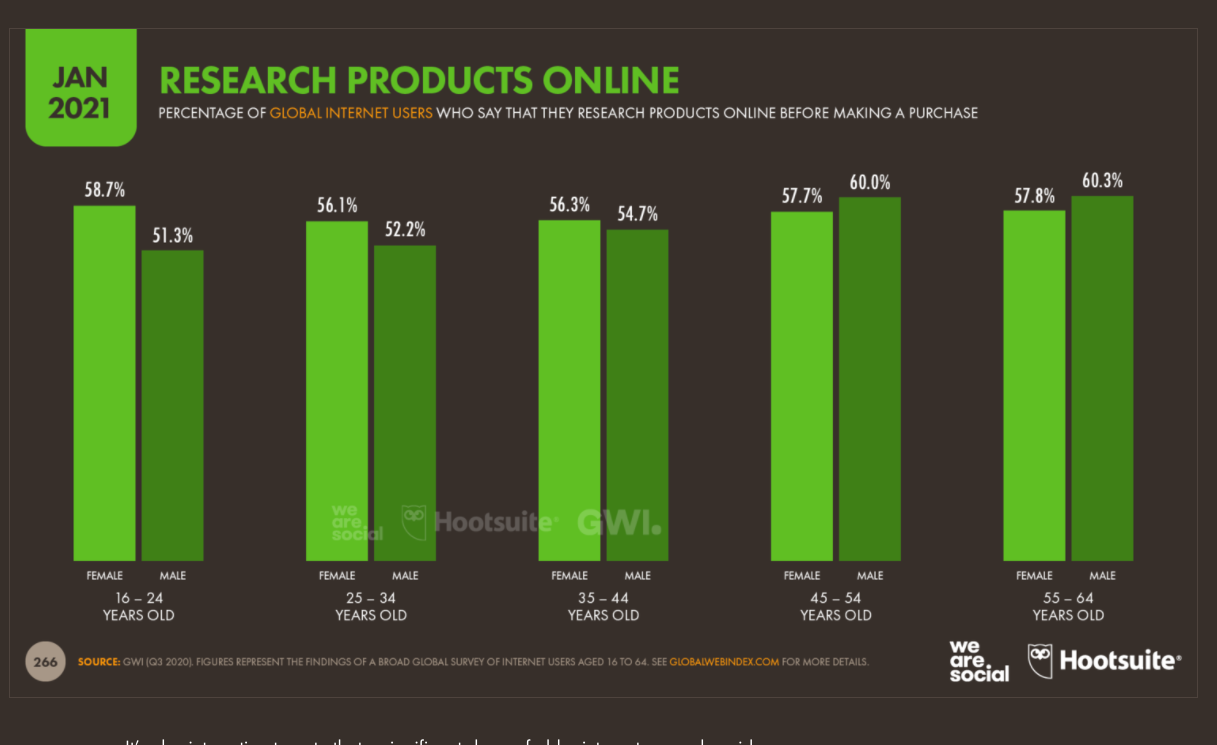I spotted this article the other day, this is the paragraph that interested me.
"A recent B2B buyer survey showed that most senior executives are using social media for business purposes - in fact, the survey found that 83% of executives who choose a vendor on behalf of their company, use social media in their decision-making, and 92% of that segment said that social media influenced a purchasing decision within the previous year."
This is insightful, but the report is from 2019, which is pre-covid. I have a rule that in the fast moving world of digital transformation, any research that is over two years old, is probably out of date. I have to be honest that any research that took place before March 2020 is probably out of date as the world during the Covid_19 pandemic has changed the world dramatically.
I wondered what research I could find that was more up to date and I found this from January 2021.
The state of the nation of social in 2021
You can get the numbers and the reports from this report here.

Essential headline
"In terms of Social media: there are now 4.20 billion social media users around the world. This figure has grown by 490 million over the past 12 months, delivering year-on-year growth of more than 13 percent. The number of social media users is now equivalent to more than 53 percent of the world’s total population."
Using social media at work

We know that 4.20 billion people use social media worldwide, but did you know that 40.4% of these people, 1.7 billion people use social media for work?
We now know our prospects and customers are on social media, but are they really social media to search, don't we go to Google for that?
Online search behaviours are changing
"Finding information is the main reason why people go online, with almost two-thirds of the world’s internet users saying this is one of their top motivations.
However, the latest research from GWI shows that the world’s search behaviours are evolving, and their changing behaviour has important consequences for anyone hoping to engage a digital audience.
Conventional search engines are still an essential part of the mix of course, with a massive 98 percent of respondents saying that they use a search engine every month."
Social search
"Perhaps the most interesting trend in evolving search behaviours is the rise of social search.
Roughly 45 percent of global internet users say that they turn to social networks at least once per month when looking for information about products or services that they’re thinking of buying."

However, that figure is considerably higher amongst younger age groups.
Indeed, Gen Z internet users are now more likely to start their brand research on social networks than they are to turn to a search engine, and trends suggest that this will soon be the case for younger Millennials too.

Our prospects are on social and they are using social to search, but how are they using social to search?
Teach me, don’t tell me
"Digging a bit deeper into online search activities, this year’s reports reveal that people are more likely to research “how to do things” on the internet than they are to look for information about specific brands, products, or services.
This finding has particular salience for marketers, because it offers valuable insights into the best ways to engage an audience.
For example, rather than merely telling people that your brand is the ideal solution for a particular problem, a ‘how-to’ video may be a more effective way of capturing their attention.
Teaching people how to get the best out of your products and services is a great way to add mutual value, improve satisfaction, and potentially boost contextual relevance and recall.
People are actively asking for this kind of content, too.

How to videos for B2B have been a mainstay for years, but this is only part of the "teach me, don't tell me" marketing mix. What can B2B Enterprise marketing and sales people do to take responsibility for this change in the way people buy and react to the change in the content that your buyers are looking for and expect.
How can you business get a competitive advantage from this?
It means that your prospect and customer ARE digital.
They are spending time on social media and if you are not there, then you are invisible.
Now most people will be thinking, we are on social, so this does not apply to me. Right? Wrong.
Being on social means:-
1. Being social - This does not mean buying ads on social, nobody looks at ads.
2. Being consistent - Some people say to us, " we are killing it on social" what they mean is they are posting something every two weeks, which again, people ignore. Every day you don't post on social you are invisible to your clients. Posting once every two weeks, means you are invisible to your clients, 13 out of 14 days.
3. Being authentic - Nobody is interested in your company or it's products, your only unique selling point (USP) is your epeople, their collective experience, their personality and their purpose.
4. Being human - Since the beginning of time, in B2B sales there has been this saying that "people buy people". It's still true. Your buyers are looking for your salespeople to be human and to share content about themselves. In our research, this is the most attractive thing you can do with your prospects and customers. It shows empathy, it build trust and it shows you are just like me.
5. Being helpful - In the world of B2B enterprise, buyers have always looked for somebody to help them. To provide them with insight, to educate, to tell them something they don't know. The challenge to you is to empower your sales team to be that "north star" in their territory, vertical, sector.
6. Not selling - Nobody likes to be sold to, so why do we do it as soon as we get to work? Salespeople are the enemy. Let's stop the "buy my product because we are great" message and be authentic, human, helpful, consistent and social and you will see a wonderful transformation happen.
Salespeople are disliked and we all avoid them, when in sales you are authentic, human, helpful, consistent and social, buyers walk towards you.
This is the transformation that takes place on social, moving away from the pitched battles with clients, the manipulation -- imagine the power of empowering your prospects and clients and people walking towards you to be your clients.
All sounds very fluffy Tim, what does this means from a $ prospective?
It would be normal that clients get a 30% increase in revenue and a 40% reduction in sales cycle.
We are seeing results better than this since the pandemic, but that's a good place for you to budget.
And finally ...
Late last year McKinsey and Co reported that its corporate clients experienced on average 7 years of digital transformation in the first six months of 2020 as they hustled to adjust to the global economic COVID disruption.
Another way to think of that statistic is that if you didn't start transforming your business in those months you are now 7 years behind your competitors!
Where Do We Go From Here?
Just give me, or one of the DLA Ignite team and hour of your time and we can walk you through what we are doing in the form of case studies, what we are doing for other businesses to transform them to digital. No hard sell, just practical examples.
DLA Ignite is a global business and we understand that a "cookie cutter" approach to digital does not work, we have to take into account local language and cultural sensitivities. Which is why we have built teams across the globe, that can support you by country and industry sector.
For more information contact me here, visit our website, or visit our Linkedin company page and contact one of the DLA Ignite team members.
Marketers in nearly every industry were forced to throw out their playbooks in 2020 because of the global health crisis. People’s daily lives were changing, so brands needed to try new things to reach audiences stuck at home. Unsurprisingly, internet videos emerged as the best channel for capturing an increasingly online audience. Data from Voices supports this claim, revealing 199% growth in this category in 2020. And, according to the Voices 2021 Annual Trends Report, videos are the top rising projects for creative professionals. Many people have more time to consume video











